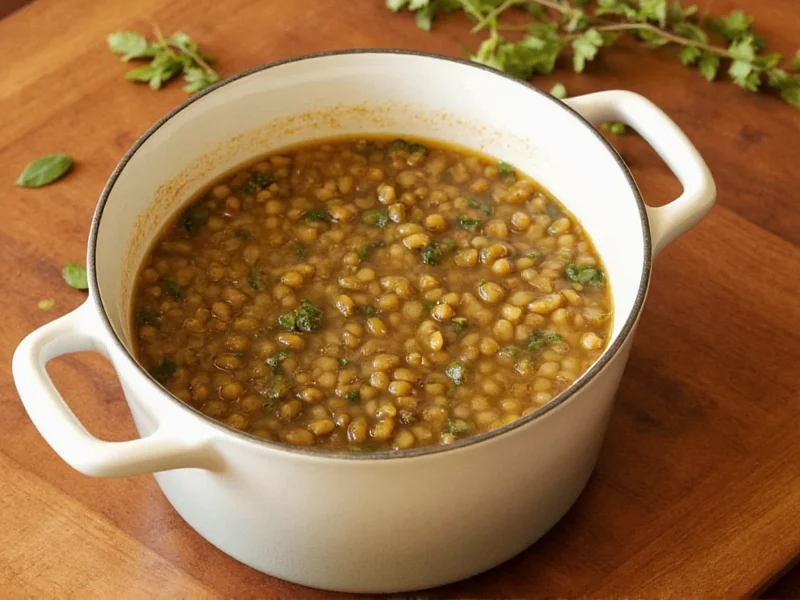Adding lentils to soup transforms a simple broth into a hearty, protein-packed meal. Whether you're making a classic lentil soup or incorporating them into vegetable, chicken, or beef soup, getting the cooking process right ensures perfect texture every time. This guide covers everything you need to know about cooking lentils in soup, from selecting the right variety to avoiding common pitfalls.
Understanding Lentil Varieties for Soup
Not all lentils behave the same in soup. Choosing the right type affects cooking time, texture, and final appearance of your dish. Here's how the most common varieties perform:
| Lentil Type | Color | Cooking Time in Soup | Best For | Texture After Cooking |
|---|---|---|---|---|
| Brown/Green | Olive green to brown | 25-35 minutes | Hearty soups, stews | Holds shape well |
| French (Puy) | Dark green with mottled skin | 25-30 minutes | Elegant soups, salads | Firm, doesn't disintegrate |
| Red/Yellow | Orange to yellow | 15-20 minutes | Creamy soups, dals | Breaks down completely |
| Black (Beluga) | Jet black | 25-30 minutes | Special occasion soups | Peppercorn-like, holds shape |
Step-by-Step Guide to Cooking Lentils in Soup
Preparation Steps
Before adding lentils to your soup, proper preparation prevents common issues:
- Rinse thoroughly - Place lentils in a fine-mesh strainer and rinse under cold water. This removes dust and small debris.
- Sort carefully - Spread lentils on a light-colored plate to spot and remove any small stones or discolored lentils.
- Don't soak - Unlike beans, lentils don't require soaking. Soaking can cause them to become mushy during cooking.
Adding Lentils to Soup
The timing of when you add lentils to soup significantly impacts the final texture:
- For broth-based soups, add lentils after aromatics (onion, celery, carrots) have softened but before adding delicate vegetables.
- For cream-based soups, add lentils at the beginning to allow full breakdown for natural thickening.
- Maintain a gentle simmer – boiling too vigorously breaks down lentils unevenly.
- Stir occasionally to prevent sticking, but avoid over-stirring which can cause mushiness.
Critical Timing Considerations
Understanding lentil soup cooking time prevents undercooked or mushy results. Most varieties need 20-35 minutes, but several factors affect this timeline:
- Acidity – Adding tomatoes, vinegar, or wine before lentils are tender can double cooking time as acid prevents softening
- Altitude – At higher elevations, increase cooking time by 15-25%
- Age of lentils – Older lentils take longer to cook; if your lentils are more than a year old, expect extended cooking time
- Water hardness – Minerals in hard water can slow the softening process
Check lentils for doneness starting at 15 minutes for red lentils or 20 minutes for green/brown varieties. They should be tender but still hold their shape (except for red lentils, which naturally break down). Overcooked lentils become mushy and lose nutritional value.
Avoiding Common Lentil Soup Mistakes
Even experienced cooks make these errors when learning how to prevent lentils from getting mushy in soup:
- Adding salt too early – While once thought to toughen lentils, modern testing shows salt can be added at any stage without affecting texture. However, adding it early enhances flavor penetration.
- Using boiling water – Start lentils in simmering liquid, not a rolling boil, for even cooking.
- Overcrowding the pot – Too many ingredients prevent even heat distribution. Maintain proper liquid-to-solid ratio (3:1).
- Adding acidic ingredients prematurely – Wait until lentils are nearly tender before adding tomatoes or vinegar.
Flavor Pairing Suggestions
Lentils absorb surrounding flavors beautifully. For the best way to cook lentils in soup, consider these classic pairings:
- Mediterranean style: Combine green lentils with rosemary, thyme, garlic, and a Parmesan rind
- Indian-inspired: Use red lentils with turmeric, cumin, coriander, and a touch of coconut milk
- French provincial: Pair Puy lentils with bacon, carrots, leeks, and a bouquet garni
- Middle Eastern: Cook red lentils with cumin, lemon juice (added at the end), and fresh cilantro
Storage and Reheating Tips
Soup with lentils often tastes better the next day as flavors meld. For optimal results:
- Cool soup completely before refrigerating (within 2 hours of cooking)
- Store in airtight containers for up to 5 days
- Freeze for up to 3 months – note that frozen then thawed lentils will be softer
- When reheating, add a splash of broth or water as lentils continue absorbing liquid while stored
- Revive flavors with a squeeze of fresh lemon or dash of vinegar after reheating
Troubleshooting Guide
Even with careful preparation, issues can arise when you're learning how to add lentils to vegetable soup properly:
- Lentils still hard after recommended time: Add 1/2 cup hot water and continue simmering. Check if you added acidic ingredients too early.
- Too mushy: Next time, reduce cooking time by 5-10 minutes or add lentils later in the process. For current batch, puree for a creamier texture.
- Bitter taste: Rinse lentils more thoroughly next time; some varieties have natural compounds that cause bitterness.
- Excessive foam: Skim foam during first 5 minutes of cooking – this removes impurities that can cause digestive discomfort.











 浙公网安备
33010002000092号
浙公网安备
33010002000092号 浙B2-20120091-4
浙B2-20120091-4